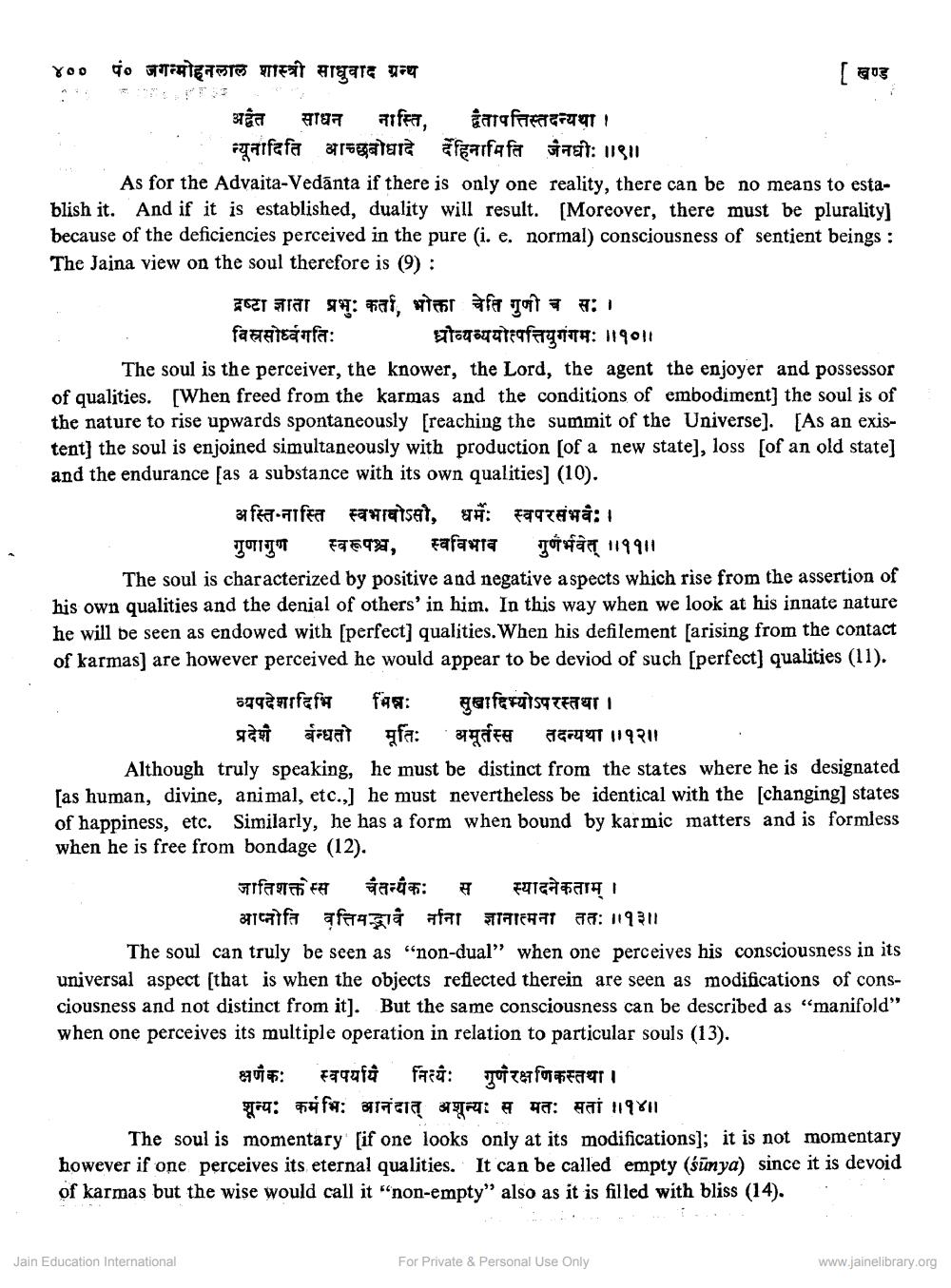________________
४०० पं० जगन्मोहनलाल शास्त्री साधुवाद ग्रन्थ
[ खण्ड अद्वैत साधन नास्ति, द्वैतापत्तिस्तदन्यथा ।
न्यूनादिति आच्छबोधादे हिनामिति जैनधीः ॥९॥ As for the Advaita-Vedānta if there is only one reality, there can be no means to establish it. And if it is established, duality will result. [Moreover, there must be plurality] because of the deficiencies perceived in the pure (i. e. normal) consciousness of sentient beings : The Jaina view on the soul therefore is (9):
द्रष्टा ज्ञाता प्रभुः कर्ता, भोक्ता चेति गुणी च सः। विस्रसोर्ध्वगतिः
ध्रौव्यव्ययोत्पत्तियुगंगमः ॥१०॥ The soul is the perceiver, the knower, the Lord, the agent the enjoyer and possessor of qualities. [When freed from the karmas and the conditions of embodiment] the soul is of the nature to rise upwards spontaneously [reaching the summit of the Universe]. [As an existent) the soul is enjoined simultaneously with production (of a new state], loss [of an old state] and the endurance [as a substance with its own qualities] (10).
अस्ति-नास्ति स्वभावोऽसौ. धर्मः स्वपरसंभवः।
गुणागुण स्वरूपश्च, स्वविभाव गुणर्भवेत् ॥११॥ The soul is characterized by positive and negative aspects which rise from the assertion of his own qualities and the denial of others' in him. In this way when we look at his innate nature he will be seen as endowed with [perfect] qualities. When his defilement (arising from the contact of karmas) are however perceived he would appear to be deviod of such [perfect] qualities (11).
व्यपदेशादिभि भिन्नः सुखादिभ्योऽपरस्तथा ।
प्रदेश बन्धतो मूतिः अमूर्तस्स तदन्यथा ।।१२॥ Although truly speaking, he must be distinct from the states where he is designated [as human, divine, animal, etc.,] he must nevertheless be identical with the [changing] states of happiness, etc. Similarly, he has a form when bound by karmic matters and is formless when he is free from bondage (12).
जातिशक्त स्स चतन्यकः स स्यादनेकताम ।
आप्नोति वत्तिमद्धावै ना ज्ञानात्मना तत: ॥१३॥ The soul can truly be seen as “non-dual" when one perceives his consciousness in its universal aspect (that is when the objects reflected therein are seen as modifications of consciousness and not distinct from it). But the same consciousness can be described as "manifold" when one perceives its multiple operation in relation to particular souls (13).
क्षणकः स्वपर्याय नित्यः गुण रक्षणिकस्तथा।
शून्यः कर्मभिः आनंदात् अशून्यः स मतः सतां ॥१४॥ The soul is momentary [if one looks only at its modifications]; it is not momentary however if one perceives its eternal qualities. It can be called empty (sünya) since it is devoid of karmas but the wise would call it "non-empty" also as it is filled with bliss (14).
Jain Education International
For Private & Personal Use Only
www.jainelibrary.org




